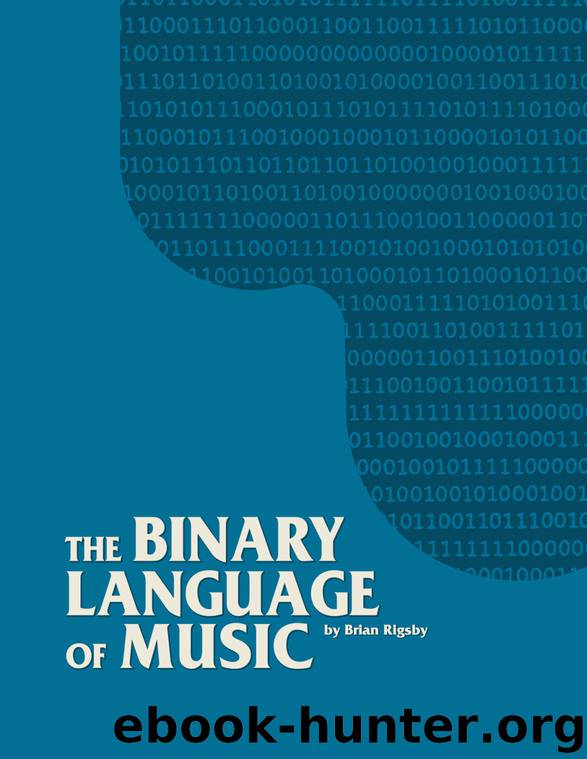The Binary Language of Music by Brian Rigsby

Author:Brian Rigsby [Rigsby, Brian]
Language: eng
Format: azw3
Published: 2017-07-29T04:00:00+00:00
Binary Rhythms
If we begin with the simplest possible rhythmic binary pattern, it is so subtle we would almost miss it - you are either playing a note, or you are not. We cannot get any more basic or foundational.
Take a look at the chart above. Forget for a moment about what these symbols are called. Let’s just say that each represents a length of time. The one at the top is the longest and the ones at the bottom are the shortest. Starting from the top we have one whole note, then two half notes, then four quarter notes, then 8th notes, 16th notes, 32nd notes, and 64th notes. 1, 2, 4, 8, 16, 32, 64. Some of you may recognize this pattern. This structure represents a perfect binary tree. But it also demonstrates a fundamental concept of our binary architecture - from one many. Just going 6 levels deep leads us to the potential for 127 different paths or outcomes. Now we are really talking about the opportunity for inspiration and discovery! We could potentially go down an unlimited number of unexplored paths.
A quick note: Remember all those sevens from the patterns section? 127 is a special number. Its binary representation is 1111111 (7 1’s).
Without even trying, we have found two fundamental and powerful binary rhythmic patterns built directly into the system. Now let’s take it a step further.
Music, in and of itself, is just a series of nebulous sounds, like a middle school orchestra warming up. It is not until we give these sounds structure that they move from being sound to being song. These structures are called forms. There are many forms and you’ve probably heard of a few: sonata, waltz, canon, even the blues is a form. And of course, there is a binary form. The binary form represents a piece of music that has only two parts - an A section and a B section. In popular music, that would traditionally be a verse and a chorus.
The following is a list of popular songs that are written in binary form:
“Candle in the Wind” - Elton John
“Every Little Thing She Does is Magic” - The Police
“Yesterday” - The Beatles
“Foxy Lady” - Jimi Hendrix
“Hotel California” - Eagles
“I Wanna Dance With Somebody” - Whitney Houston
“Proud Mary” - Creedence Clearwater Revival
“Sweet Home Alabama” - Lynyrd Skynyrd
“Just the Way You Are” - Billy Joel
“Oops, I Did It Again” - Britney Spears
“Somebody That I Used To Know” - Gotye
“Somewhere Over the Rainbow” - Harold Arlen
“Happy” - Pharrell Williams
Melodic Binary
In order to discuss binary patterns in melody, we must start with the building blocks of melody - intervals. An interval is just a fancy way of describing the distance between two notes. For example, if we were to play a C on piano and then play the next highest C, that distance or interval would be an octave. The distance between any starting or root note (C, F#, Db, etc.) and each note in its octave all have names, but since we are in the world of binary, we will only focus on two.
Download
This site does not store any files on its server. We only index and link to content provided by other sites. Please contact the content providers to delete copyright contents if any and email us, we'll remove relevant links or contents immediately.
Aircraft Design of WWII: A Sketchbook by Lockheed Aircraft Corporation(32140)
The Great Music City by Andrea Baker(30801)
Call Me by Your Name by André Aciman(19934)
The Art of Boudoir Photography: How to Create Stunning Photographs of Women by Christa Meola(18415)
The Secret History by Donna Tartt(18232)
Shoot Sexy by Ryan Armbrust(17565)
Plagued by Fire by Paul Hendrickson(17119)
Portrait Mastery in Black & White: Learn the Signature Style of a Legendary Photographer by Tim Kelly(16878)
Adobe Camera Raw For Digital Photographers Only by Rob Sheppard(16806)
Photographically Speaking: A Deeper Look at Creating Stronger Images (Eva Spring's Library) by David duChemin(16506)
Ready Player One by Cline Ernest(14034)
Pimp by Iceberg Slim(13808)
Bombshells: Glamour Girls of a Lifetime by Sullivan Steve(13706)
The Goal (Off-Campus #4) by Elle Kennedy(13213)
Art Nude Photography Explained: How to Photograph and Understand Great Art Nude Images by Simon Walden(12859)
Kathy Andrews Collection by Kathy Andrews(11345)
The Priory of the Orange Tree by Samantha Shannon(8644)
Thirteen Reasons Why by Jay Asher(8472)
The remains of the day by Kazuo Ishiguro(8419)
